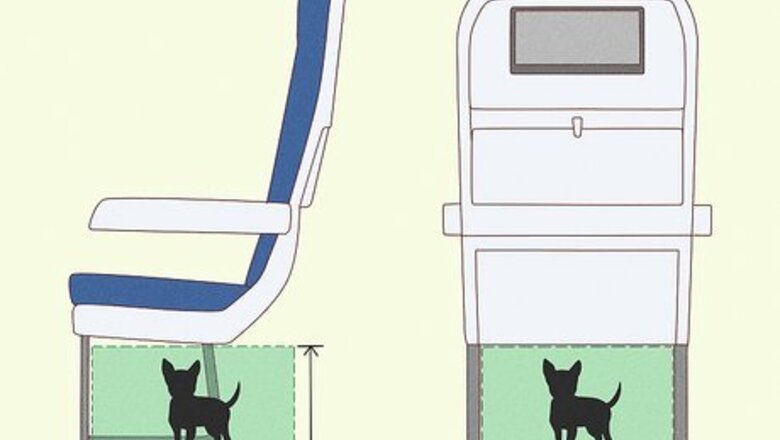
views
Make sure your dog qualifies to fly.
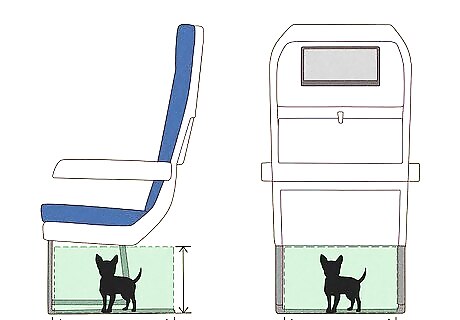
If your dog is too big to fit under an airline seat, you can’t do this. You can usually bring a dog in the cabin with them so long as they’re small enough to fit in a carrier that fits underneath the seat in front of you on the plane. They must also be able to stand up and turn around in their crate. If your dog can’t meet these requirements, they can’t fly in the cabin. The dimensions of the area under the seat differ from plane to plane, and airline to airline. You can look them up online, but in most cases you’ll be restricted to flying with toy breeds.
Review the airline’s policies before booking tickets.
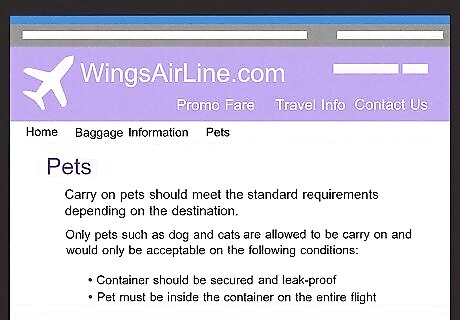
Most airlines allow dogs in the cabin, but double-check to be safe. Smaller airlines, niche regional providers, and certain budget airlines often don’t allow non-service dogs on the plane—even if they do fit in a carry on. Make sure dogs are allowed with whatever airline you’re thinking of booking a ticket with. Then, review their policies for bringing dogs on their planes. You’ll likely need a health certificate signed by a veterinarian. This will demonstrate that your dog isn’t carrying any infectious diseases and that they’re not going to spread fleas all over the airplane.
Add your dog to the ticket when you book it.
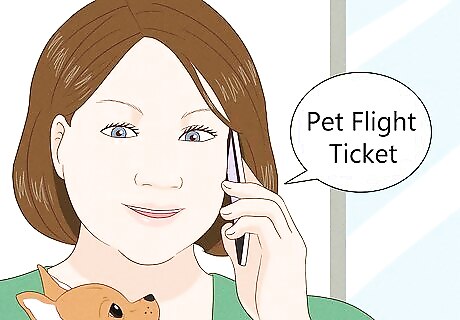
Call to buy your ticket so you can make arrangements for your dog. When you book tickets online, there isn’t usually an option to add a dog. If there is, go ahead and book online! If there isn’t though, call the airline to book your ticket with them directly. Explain that you’re bringing your dog and they’ll walk you through the process to reserve your dog’s spot on the plane. The fee for bringing a pet on board is typically $50-300 depending on who you choose to fly with. Airlines typically have a hard limit on the number of pets they let on a plane. If you don’t tell the airline you’re bringing a pet, they may fill up to their max and refuse to let you board with your dog.
Get an airline-approved carrier.
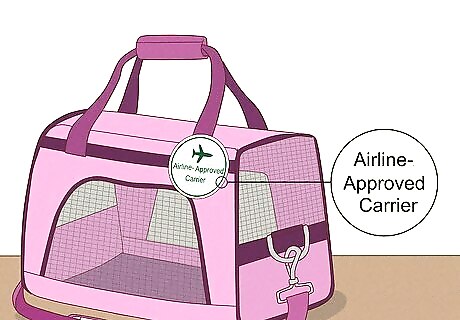
You need a special carrier that the airlines will allow. Normally, it will say “airline approved” or “air in-cabin approved” on the tag. These carriers are typically soft, and meet certain requirements the airlines have in terms of weight and shape. Buy airline-approved pet carriers online or in a pet store. Most airline carriers list requirements for carriers you can keep your dog in on their website.
Let your dog get acclimated to the new carrier.
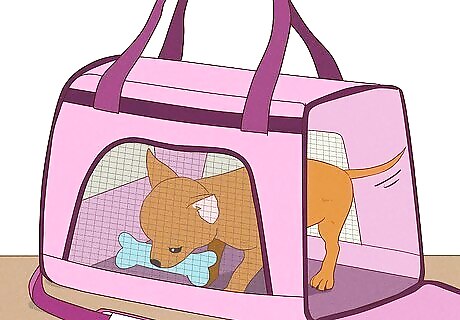
Introduce the carrier by letting your dog hang around it. Give your pup a chance to smell and hang out in the carrier well before your trip. Give them treats if they go inside of it or play around it. The more positive you can make the crate for your dog, the calmer they’ll be when they're inside of it.
Take your dog to the vet 30 days before your flight.
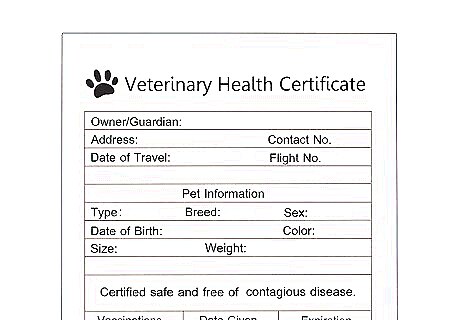
Ask the vet for a health certificate so your pup can fly. The airline will let you know what’s required on the health certificate when you buy the ticket. Typically, it’s just a checkup to confirm that your dog doesn’t have any infectious diseases. Schedule a visit with your vet, explain that you’re flying with your pup, and give them the paperwork they need to sign off on. Bring this paperwork with you to the airport on the day of the flight. You may need to show it to the attendant as you’re boarding the plane. Some airlines do not require a health certificate. You may be able to skip this step depending on who you’re flying with. Even if it isn’t a requirement, it’s still a good idea to see a vet just to make sure they’re healthy enough to fly.
Ask your vet about sedatives if your pup isn’t naturally calm.
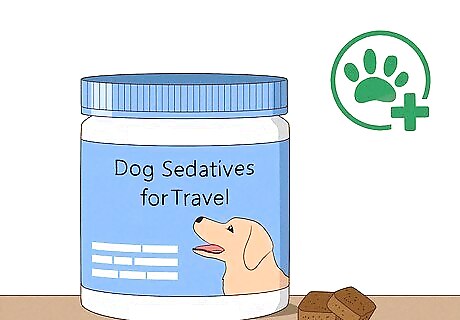
Most dogs don’t need sedatives, but they may help if your dog gets nervous. You know your dog better than anyone else. If they get a little anxious or they act out when they’re overwhelmed, ask your vet about sedatives for travel. They may give you something to calm your dog down throughout the flight. If they do, go on a “dry run” a few days before to make sure your dog can handle the medication if your vet thinks it’s a good idea. Do not give your dog anything to calm them down if it isn’t prescribed or recommended by a veterinarian. The vast majority of dogs do not need sedatives to fly. So long as you pay them proper attention and you spend time with them throughout the flight, it should be fine.
Get an anxiety-reducing collar or shirt if necessary.
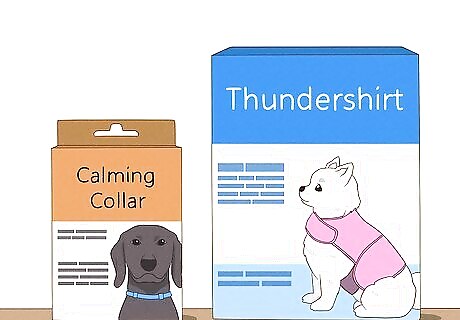
Even without sedatives, you can purchase a calming collar or shirt for your pup. If your dog can get a little anxious but your vet doesn’t think sedatives are appropriate, get a Thundershirt or a calming collar. A Thundershirt is basically a comfortable but tight sweater that will keep your dog relaxed. Calming collars have pheromones that will help reduce anxiety. Don’t give them any OTC anxiety medication without vet approval. The collar or calming shirt are also good options if you’re worried about giving your dog medication but you still want to help them take the edge off.
Put your dog’s tags on and label the crate.
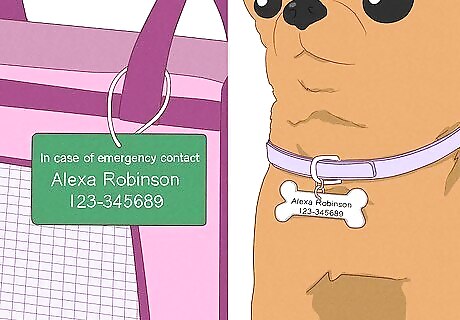
Make sure your contact info is on your pup and their container. This way, if something awful happens and you somehow get separated from your furry friend, people will be able to reach you. Put all of your dog’s vaccine tags on their collar, and make sure your phone number and name are listed on at least one of their tags. Put a label on their crate as well, just in case someone picks it up thinking that it’s lost luggage. If you haven’t already, consider microchipping your dog so that they can be returned to you if they end up getting lose and running away. The odds are very low that you’re going to be separated from your dog, but it’s better to be safe than sorry. Also, you’ll have a bit of peace of mind!
Don’t feed your dog the day of the flight.
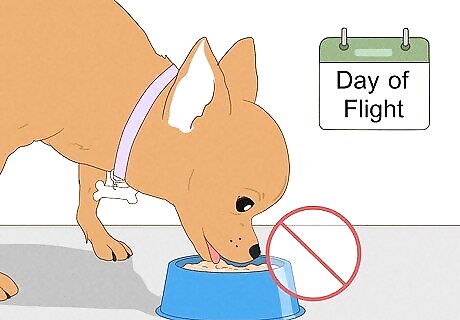
Unless you’re flying super late, plan on feeding your dog when you land. Your dog will be less likely to throw up or get nauseous if they’ve got an empty stomach. On top of that, this will minimize the odds that they need to poop mid-flight, which might be a major pain to clean up. Give them water periodically throughout the day, but cut back a few hours leading up to the flight. If you’re flying late at night, it’s a little cruel not to feed your dog. Give them breakfast and/or lunch, but cut back on food in the 4-6 hours leading up to the flight.
Tire your pup out before the flight.
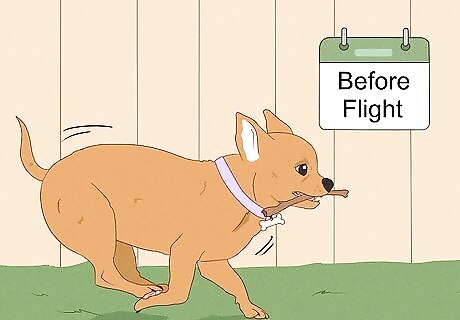
A few hours before you’re leaving, give your dog a workout. Take them on an extra long walk, play fetch with them in an enclosed yard, or break out the rope toy and play tug-of-war for a while. Try to time it so that your dog is tired out right before you leave to go to the airport. Dogs are calmer when they’re tuckered out, and if you do this right, your dog may just happily sleep through the flight! Your dog is likely going to have a few hours here where they’re not able to move around. Giving them plenty of time to exercise before you board is the kind thing to do.
Bring your dog’s documentation to the airport.
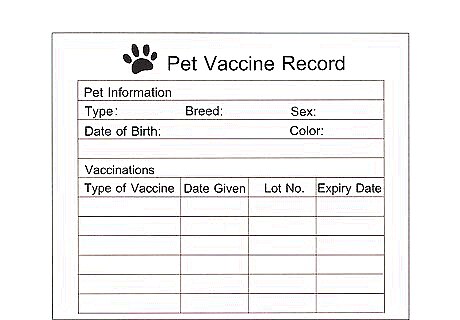
Even if you don’t need a health certificate, bring their vaccine records. Before the day of your flight, run copies of your dog’s most recent vaccination records. It may never come up on your travels, but if there’s some random regulation you don’t know about and you run into a super by-the-book TSA agent or something, you’ll be happy you have proof you aren’t bring a rabid dog into the airport. If you do need a health certificate for the airline, print a copy and leave that at home. Bring the original to the airport with you.
Arrive at the airport at least 1 hour earlier than normal.
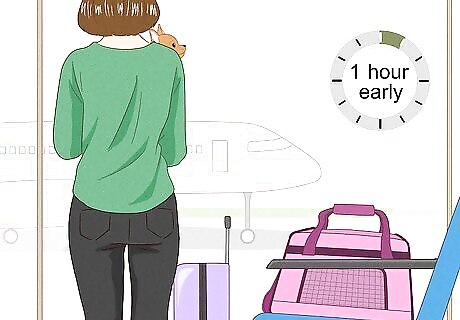
Give yourself a time buffer to handle any issues that come up. Aside from the fact that security can be a bit of a pain, you’ll want time to give your dog a mini-walk before you go into the airport, or after you get past security. Showing up at least 1 hour than you would if you were alone also gives your dog plenty of time to take in the sights and smells of the airport. This can help desensitize them to the chaos, which will help them stay calm on the plane. Bringing your dog through security seems scary, but it’s usually straightforward. Your carrier will go through the X-ray machine, and you’ll hold your dog while you go through the scanner.
Take your dog to the bathroom before you board.
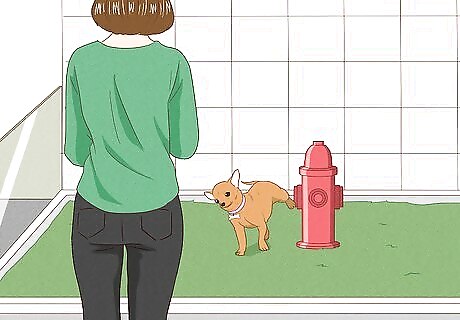
Even if they don’t go, give them the opportunity before boarding. You can either walk them along a hedge outside of the airport, or see if there’s an indoor pet relief area with artificial grass areas in the airport. Make sure they use the potty at some point before you board. You cannot your dog out of the carrier on the plane, so it’s essential that they use the bathroom before you reach the gate. If they don’t go to the bathroom before you go into the airport and they end up needing to go, you’ll have to leave the airport and go back through security again if there’s no pet relief area. Line their carrier with a puppy pad or two just in case they need to go on the plane.
Keep your pup extra calm at the gate.

Airlines can (and will) deny boarding if a dog is acting out. If your dog is barking excessively, growling, or lashing out in their carrier, the airline employees may turn you away at the gate. Give your dog head scratches, hush them, or give them a chew toy to keep them calm before (and as) you board. It doesn’t matter if your dog is a service animal either, so make sure you give them plenty of reassurance at the gate. You know your dog best. If they calm down once they get their growling and barking out of their system, just wait for them to relax somewhere far away from your boarding gate.
Give your dog plenty of love on the plane.
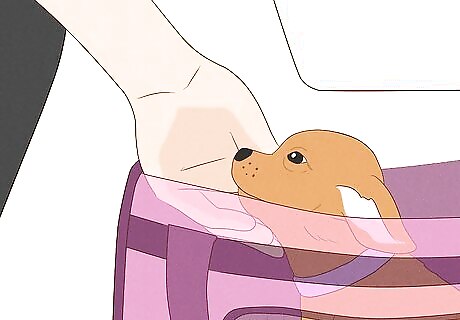
You can’t take them out of the crate, but you can still pet them! If your dog lies down immediately to go to sleep once you board, leave them alone. But if they’re up, or they seem anxious, open the zipper on the carrier and give them a few quick pets. Whisper soothing sounds to them and smile. If you’re calm, they’ll be calm. Don’t wake your dog up to interact with them on the plane. If they’re sleeping, literally let that sleeping dog lie—it’s a best case scenario if they snooze.
Take your dog out ASAP once you land.
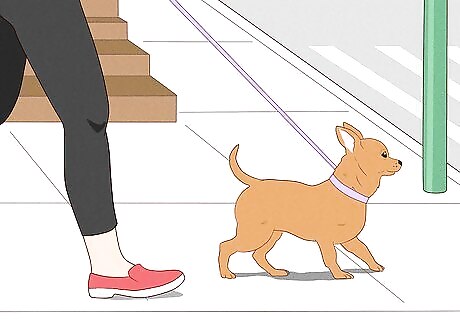
As soon as you can after landing, give them a long walk and some play time. Once you get out from the airport, leash your pup and let them out of the carrier. Give them some space to stretch their legs, use the bathroom, and move around a bit. Do your best to take them on a long walk after you get to the hotel or wherever you’re staying. Your pup went through a lot on the plane (even if it doesn’t look like it), so they deserve some love.



















Comments
0 comment